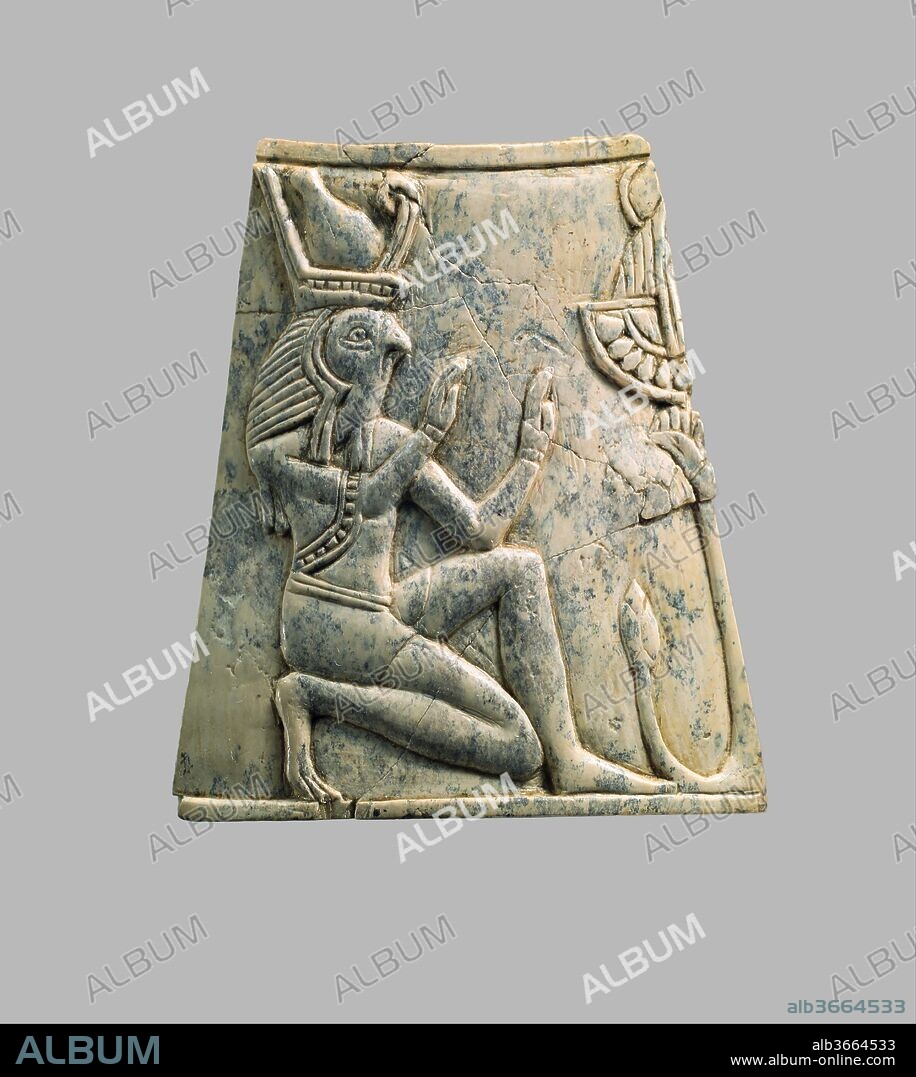alb3664533
Plaque with falcon-headed Re wearing crown of Upper and Lower Egypt

|
Ajouter à une autre Lightbox |
|
Ajouter à une autre Lightbox |



Avez-vous déjà un compte? S'identifier
Vous n'avez pas de compte ? S'inscrire
Acheter cette image

Titre:
Plaque with falcon-headed Re wearing crown of Upper and Lower Egypt
Légende:
Voir la traduction automatique
Plaque with falcon-headed Re wearing crown of Upper and Lower Egypt. Culture: Assyrian. Dimensions: H. 2 13/16 x W. 1 5/8 x D. 2 7/16 in. (7.1 x 4.1 x 6.2 cm). Date: ca. 8th-7th century B.C..
This curved, trapezoidal ivory plaque was found in a storage room in Fort Shalmaneser, a royal building at Nimrud that was used to store booty and tribute collected by the Assyrians while on military campaign. It depicts a figure with the head of a falcon kneeling with elbows bent and palms held outwards, facing a stylized tree to the right. The figure wears a type of Egyptian headdress called a lappet wig, topped by a version of the Egyptian double crown which has a curled element added at the front. He is dressed in a belted garment with short skirt and loose, short sleeves, decorated with a beaded border, and is barefoot. The stylized tree is made up of a vertical trunk topped by a palmette and a curving branch rising from the root, topped by a bud; presumably the other half of the tree would have been symmetrical, and was depicted on the adjoining plaque to the right when this plaque was still in its original setting. Atop the palmette is an element combining a wide Egyptian necklace called a broad collar and an isolated head, visible only in the edge of the headdress represented by parallel vertical lines and part of a sun disc. Like the tree, this element would have been completed on the adjoining plaque, which is now missing, but enough remains to suggest that it was an aegis, an image of the head and shoulders of a deity. An ivory aegis of a feline goddess from Nimrud, in the collection of the Metropolitan Museum, gives an idea of how the complete element might have looked. Carved ivory pieces such as this were widely used in the production of elite furniture and luxury objects during the early first millennium B.C., and could be overlaid with gold foil or inlaid to create a dazzling effect of gleaming surfaces and bright colors. This piece is one of many elaborately carved ivories with motifs adapted from Egyptian art that have been attributed to Phoenician workshops, as Phoenician art shows strong Egyptian influence. It was found with many other small curved trapezoidal plaques, suggesting that these pieces were originally fitted together to create ring-shaped objects that were wider at the bottom than the top. If equipped with bases and lids, these plaques could have been used as boxes, or alternatively they could have served as stands for bowls or round-bottomed goblets.
Built by the Assyrian king Ashurnasirpal II, the palaces and storerooms of Nimrud housed thousands of pieces of carved ivory. Most of the ivories served as furniture inlays or small precious objects such as boxes. While some of them were carved in the same style as the large Assyrian reliefs lining the walls of the Northwest Palace, the majority of the ivories display images and styles related to the arts of North Syria and the Phoenician city-states. Phoenician style ivories are distinguished by their use of imagery related to Egyptian art, such as sphinxes and figures wearing pharaonic crowns, and the use of elaborate carving techniques such as openwork and colored glass inlay. North Syrian style ivories tend to depict stockier figures in more dynamic compositions, carved as solid plaques with fewer added decorative elements. However, some pieces do not fit easily into any of these three styles. Most of the ivories were probably collected by the Assyrian kings as tribute from vassal states, and as booty from conquered enemies, while some may have been manufactured in workshops at Nimrud. The ivory tusks that provided the raw material for these objects were almost certainly from African elephants, imported from lands south of Egypt, although elephants did inhabit several river valleys in Syria until they were hunted to extinction by the end of the eighth century B.C.
Technique/matériel:
MARFIL
Période:
NEOASIRIO
Musée:
Metropolitan Museum of Art, New York, USA
Crédit:
Album / Metropolitan Museum of Art, NY
Autorisations:
Modèle: Non - Propriété: Non
Questions sur les droits?
Questions sur les droits?
Taille de l'image:
3545 x 3965 px | 40.2 MB
Taille d'impression:
30.0 x 33.6 cm | 11.8 x 13.2 in (300 dpi)
Mots clés:
 Pinterest
Pinterest Twitter
Twitter Facebook
Facebook Copier le lien
Copier le lien Email
Email
